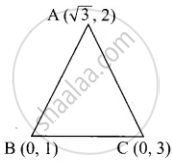Advertisements
Advertisements
प्रश्न
Show that the following points taken in order to form an equilateral triangle
`"A"(sqrt(3), 2), "B"(0, 1), "C"(0, 3)`
उत्तर

Distance = `sqrt((x_2 - x_1)^2 + (y_2 - y_1)^2`
AB = `sqrt((0 - sqrt(3))^2 + (1 - 2)^2`
= `sqrt((- sqrt(3))^2 + (-1)^2`
= `sqrt(3 + 1)`
= `sqrt(4)`
= 2
BC = `sqrt((0 - 0)^2 + (3 - 1)^2`
= `sqrt(0^2 + 2^2)`
= `sqrt(4)`
= 2
AC = `sqrt((0 - sqrt(3))^2 + (3 - 2)^2`
= `sqrt((- sqrt(3))^2 + 1^2)`
= `sqrt(3 + 1)`
= `sqrt(4)`
= 2
AB = BC = AC ...(Three sides are equal)
∴ ABC is an equilateral triangle.
APPEARS IN
संबंधित प्रश्न
If the co-ordinate of A is x and that of B is y, find d(A, B).
x = 6, y = - 2
Co-ordinates of the pair of a point is given below. Hence find the distance between the pair.
3, 6
Co-ordinates of the pair of points are given below. Hence find the distance between the pair.
0, - 2
If P-Q-R and d(P, Q) = 3.4, d(Q, R)= 5.7 then d(P, R) = ?
Determine whether the given set of points are collinear or not
(7, −2), (5, 1), (3, 4)
Show that the following points taken in order to form the vertices of a parallelogram
A(−7, −3), B(5, 10), C(15, 8) and D(3, −5)
Verify that the following points taken in order to form the vertices of a rhombus
A(3, −2), B(7, 6), C(−1, 2) and D(−5, −6)
The distance between the point (5, −1) and the origin is _________
Find the distance with the help of the number line given below.

d(B, E)
Find the distance with the help of the number line given below.

d(P, C)
